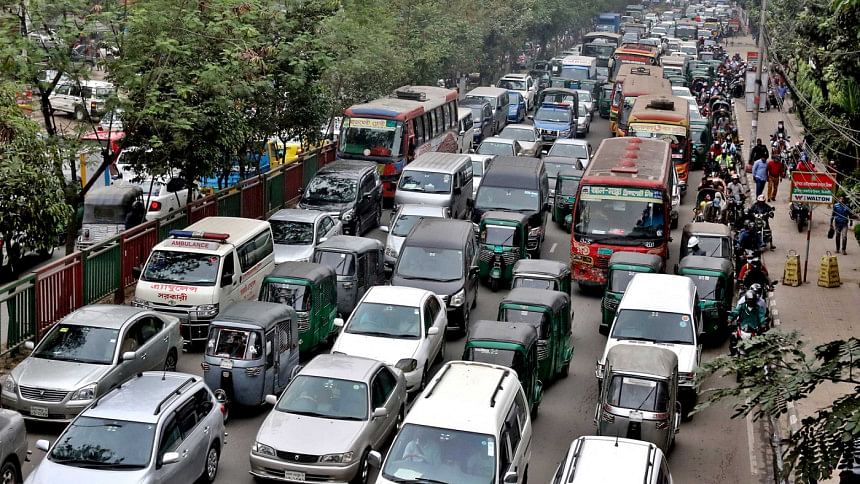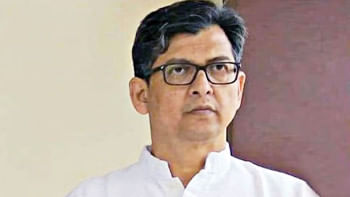Road deaths, and our infatuation with motorised transport

As children and others continue to die on our roads, we ought to reconsider just how highly we value our current traffic system. How many deaths and serious injuries are we willing to accept for the sake of the possibility—belied by our constant traffic congestion—of free movement throughout our city? Likewise, if we implemented all of the students' demands, just how much could we reduce the ongoing slaughter on the roads?
It is easy to believe that if we solved the most egregious problems—crazy driving, lack of proper training or monitoring, the terrible state of vehicles and roads—then we could bring the death toll to a rapid end. Surely, the high-income countries do not suffer the same carnage as we do here in South Asia?
The statistics may, thus, come as a shock. While Bangladesh has 13.6 road deaths per 100,000 inhabitants per year, the US is not much better, at 12.4, and Sri Lanka—which in many ways has a more civilised road system—does even worse, at 17.4. The worst countries are in Africa and the best are in Europe, though Hong Kong, at just 1.5, has the lowest road death rate in the world, doing even better than countries such as Norway, Sweden, and Switzerland, all of which have around two deaths per 100,000 inhabitants per year.
What do all those confusing numbers tell us, except that the US is, as usual, a poorly-performing outlier? Well, the countries that have done the most to reduce the use of the automobile, improve public transit, and make it pleasant to move about by foot and bicycle do the best in increasing road safety, while those that continue to prioritise using cars do the worst. The simple fact is that motorised vehicles weighing more than a tonne, travelling at over 30km per hour, are deadly. No matter how many measures we put into place to make things safer, accidents will happen, due to any number of reasons—a child running into the street after a ball, low visibility due to fog or rain, a momentary lapse of attention.
Worse, the very fact of driving a big motorised vehicle gives a feeling of power and invulnerability to the driver—and reduces those on the roads to something less than fully human. I sometimes have the same sensation on a bicycle—pedestrians are an annoying obstacle to my progress. It is vastly worse if I am driving a car, which is partly why I stopped decades ago. When I reduce the people who I share the streets with to something less than human, I lose some of my own humanity. The convenience of a car is not worth it.
So yes, we should implement some of the measures the students demand. My main contention previously was with their demand for foot overbridges. I understand not trusting Bangladeshi drivers to respect zebra crossings, but rather than accepting that situation, we need strict enforcement of the rules. Not only do many people not enjoy climbing stairs for the sole purpose of crossing a road, but foot overbridges send a clear message that the roads belong to the vehicles, and pedestrians should flee for their safety. Where there is no bridge available and people need to cross the road, or where there is no footpath or it is piled with garbage, construction materials or parked vehicles, and pedestrians have no choice but to walk in the roads, the drivers will not slow down for them. Why should they? They assume that pedestrians have no right to be on the roads, despite the fact that walking is, like driving, another (though vastly less harmful) form of transport.
In the Netherlands, when people were fed up with the ongoing road deaths, particularly of children, the public moved not to demand stronger laws or higher penalties, but to create a high quality network of protected bicycle paths, so that people could move about without causing danger to themselves or others. The resulting bicycle network is enviable and helps explain the high rate of bicycle commuting in the Netherlands—and the low death rate on the roads. Hong Kong, in order to avoid the state of a permanent traffic jam, has actively discouraged car ownership and use, and instead promotes public transit and walking.
The US, meanwhile, is a disaster because the founding principle is sprawling and driving, rather than setting up compact cities that enable and encourage using public transit, walking and cycling.
To put it plainly, at some point, we must decide whether our continued infatuation with motorised transport and our consideration of it as our default transport option are worth the price in life and limb. If not, simple tweaking at the edges will not solve our problem; a major reconfiguration of transport systems to dramatically reduce motorised transport and encourage and enable walking, cycling and using public transit will save lives from road crashes—as well as from pollution. As a side benefit, we would also have vastly more liveable cities.
Debra Efroymson is the executive director of the Institute of Wellbeing, Bangladesh, and author of "Beyond Apologies: Defining and Achieving an Economics of Wellbeing."

 For all latest news, follow The Daily Star's Google News channel.
For all latest news, follow The Daily Star's Google News channel. 



Comments